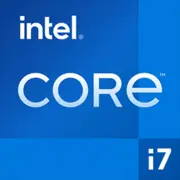Intel Core i7-14650HX

Intel Core i7-14650HX: Power for Professionals and Gamers in 2025
Analysis of capabilities, usage scenarios, and laptop selection recommendations
Architecture and Process Technology: Hybrid Power of Raptor Lake-HX
The Intel Core i7-14650HX processor, built on the Raptor Lake-HX architecture, combines innovations in hybrid design with Intel's 10-nanometer process technology (Intel 7). Its key features include:
- 16 cores (8 Performance-cores + 8 Efficient-cores) and 24 threads: The P-cores (Performance) function with Hyper-Threading (2 threads per core), providing high performance in single-threaded tasks, while the E-cores (Efficient) are optimized for multi-threaded operations with lower power consumption.
- Clock Frequencies: The base frequency of the P-cores is 2.2 GHz, but in Turbo Boost Max 3.0 mode, the processor can boost up to 5.2 GHz for instant execution of resource-intensive tasks.
- Cache Memory: A 30 MB L3 cache accelerates data processing, reducing latency when working with heavy applications.
- Integrated Graphics UHD Graphics 710: A 16-core iGPU with a base frequency of 300 MHz and support for 4K displays. This solution is suitable for office tasks and video playback, but a discrete graphics card is needed for gaming or 3D rendering.
The Raptor Lake-HX architecture maintains compatibility with Intel's 700 series chipsets, simplifying integration into modern laptops.
Power Consumption and TDP: A Balance Between Power and Efficiency
The nominal TDP of the processor is 55W, but in turbo mode, consumption can reach 157W (PL2). This places demands on the cooling system:
- Laptops with the i7-14650HX are equipped with massive heatsinks and powerful fans. For example, the ASUS ROG Strix G17 (2025) uses liquid metal thermal paste and six heat pipes to minimize throttling.
- Power-saving Technologies:
- Intel Dynamic Tuning automatically adjusts power based on workload.
- Speed Optimizer increases frequencies when plugged in, lowering them when on battery.
For mobile workstations, this is an optimal choice, but such a processor is rarely found in ultrabooks due to cooling challenges.
Performance: Real-World Tasks and Gaming Capabilities
The results of Geekbench 6 tests (2716 Single-Core / 13858 Multi-Core) place the i7-14650HX at the top of mobile CPUs for 2024-2025.
Office and Multimedia
- Microsoft Office + 50 Chrome Tabs: No lag even when simultaneously working with Excel spreadsheets and video conferences.
- 4K Video Editing in DaVinci Resolve: Rendering a 10-minute project takes around 8 minutes, thanks to 24 threads.
Gaming
- Paired with the NVIDIA GeForce RTX 4070 (laptop version), the processor achieves 120+ FPS in Cyberpunk 2077 (Ultra settings, DLSS Quality). Turbo mode is activated in peak scenes, but prolonged sessions may lead to temperatures rising to 95°C.
- Important: The UHD Graphics 710 is only suitable for older games like CS:GO at low settings (60-80 FPS).
Turbo Mode: Pros and Cons
- A brief boost up to 5.2 GHz speeds up application launches and request processing.
- Under constant load (e.g., video rendering), the frequency of the P-cores stabilizes around ~4.3 GHz due to TDP limitations.
Usage Scenarios: Who is the i7-14650HX For?
1. Professionals:
- Video editors, 3D designers, programmers (code compilation, virtualization).
- Example: The MSI CreatorPro Z16 (2025) with the i7-14650HX and RTX 4080 is ideal for work in Blender and Unreal Engine.
2. Gamers: Paired with discrete graphics at the level of RTX 4060 and above.
3. General Users: Those who appreciate surplus power for multitasking.
Battery Life: The Price of Performance
Under active use, the battery life rarely exceeds 3–4 hours (e.g., during rendering or gaming). In office mode (50% brightness, Wi-Fi, text editors) — up to 6 hours.
Energy-saving Technologies:
- Intel Adaptive Brightness: Reduces screen power consumption.
- Chipset Power Management: Disables unused controllers.
Tip: Choose laptops with a battery of at least 90 Wh (e.g., Lenovo Legion Pro 7i) to compensate for high TDP.
Comparison with Competitors
- AMD Ryzen 9 7945HX (Zen 4): 16 cores, 32 threads, 55W TDP. Better in multi-threaded tasks (Cinebench R23: 32,000 vs. 29,500 for Intel) but lags in single-threaded (Geekbench 6 SC: 2580).
- Apple M3 Pro (3 nm): Energy efficiency (18 hours of battery life) and a powerful Neural Engine, but limited compatibility with Windows software.
- Intel Core i7-13650HX: Previous generation, 5–10% weaker in multi-threaded tests.
Pros and Cons
Strengths:
- Record-breaking multi-threaded performance.
- Support for DDR5-5600 and PCIe 5.0.
- Compatibility with powerful discrete GPUs.
Weaknesses:
- High power consumption.
- Integrated graphics unsuitable for gaming.
- Heating under load.
Laptop Selection Recommendations
1. Type of Device:
- Gaming Laptops (starting at $1600): ASUS ROG, MSI Raider.
- Mobile Workstations (from $2000): Dell Precision, HP ZBook.
2. What to Look For:
- Cooling System: Minimum of two fans and four heat pipes.
- RAM: 32 GB DDR5.
- Storage: 1 TB PCIe 4.0 NVMe.
- Display: For professionals — 4K IPS; for gamers — QHD with 240 Hz.
Final Conclusion
The Intel Core i7-14650HX is a processor for those not willing to sacrifice performance for mobility. It is ideal for:
- Professionals working with resource-intensive applications.
- Gamers combining it with top-tier discrete graphics.
- Enthusiasts who value cutting-edge technology.
The main advantage is its ability to switch instantly between everyday tasks and professional workloads. However, if you need battery life over 8 hours, consider Apple M3 or AMD Ryzen 7 7840U processors.
Examples of 2025 Laptops with i7-14650HX:
- Acer Predator Helios 16 (starting at $1700): RTX 4070, 32 GB DDR5, QHD 240 Hz.
- HP Omen Transcend 17 (from $1850): Mini-LED display, 2 TB SSD.
Basic
CPU Specifications
Memory Specifications
GPU Specifications
Benchmarks
Compared to Other CPU
Share in social media
Or Link To Us
<a href="https://cputronic.com/cpu/intel-core-i7-14650hx" target="_blank">Intel Core i7-14650HX</a>





